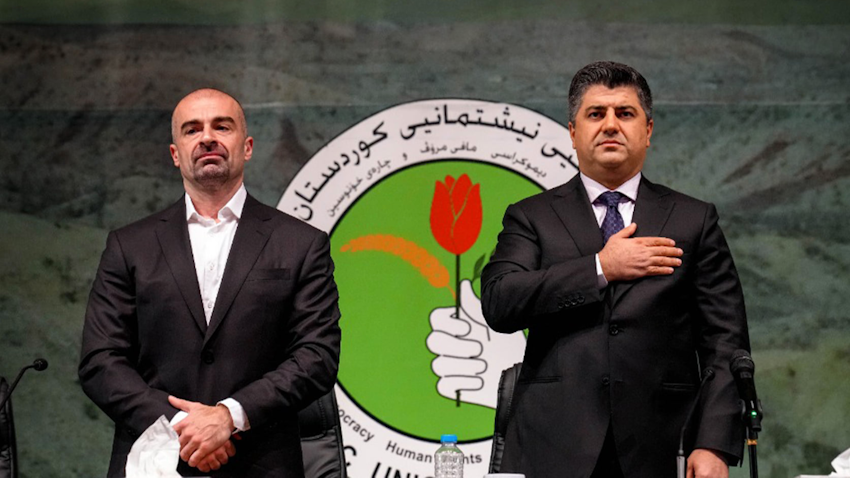Why Lahur Sheikh Jangi Resisted Arrest and Why Bafel Talabani Responded with Overwhelming Force

The arrest of Lahur Sheikh Jangi became one of the most controversial episodes in recent Kurdish politics, both for the scale of force deployed and the dramatic circumstances surrounding his capture. Video footage of the moment sparked widespread shock, showing Lahur being held by Wahab Halabjayee, commander of the PUK’s counter-terrorism unit. In a particularly jarring scene, another fighter appears to slap Lahur, though Halabjayee seems to intervene. The imagery was made even more striking by the fact that before Bafel Talabani’s 2021 coup, Halabjayee had been one of Lahur’s closest confidants.
What stands out most about the operation is the overwhelming force Bafel chose to deploy. Several thousand fighters—armed with weapons supplied by coalition forces, including heavy weapons and tanks—were mobilized to arrest one man and roughly 200 guards. The irony was not lost on observers: just a day earlier, Lahur had attended a funeral with only a handful of guards and could easily have been arrested without such dramatic measures.
This appears to have been entirely deliberate. Two days before the operation, Talabani had told journalists he intended to arrest Lahur inside his compound and hinted at using overwhelming force if he resisted. According to Rudaw TV, the operation involved approximately 150 explosive-laden drones, nearly 1,000 mortar rounds, nine tanks, 100 armored vehicles, and 150 lighter military vehicles—weapons originally supplied by the U.S. and France for fighting ISIS. Many argue this was a calculated show of strength designed to spread fear and send a clear message about Talabani’s authority.
The assault itself appears to have been methodically planned. Commando forces and Asayish operations units surrounded the compound’s perimeter, while the U.S.-trained Counterterrorism unit led the assault inside. The battle lasted three and a half hours, from 3:00 a.m. to 6:30 a.m., with both the head of the Kurdistan Security Agency and Bafel Talabani personally calling Lahur to demand his surrender—requests he repeatedly refused.
Assault on Lahur Sheikh Jangi's Compound
Force Roles & Deployment
Counterterrorism Unit
(U.S. Trained)
Led the direct assault inside the compound.
Commando Forces
(France Trained)
Surrounded and fought on the outer perimeter.
Asayish Operations
Secured the outer perimeter alongside Commandos.
Deployed PUK Forces & Equipment
9
Tanks
~1,000
Mortar Rounds
~150
Drones
~100
Armored Vehicles
~150
Lighter Military Vehicles
*Equipment originally supplied by U.S. & France for anti-ISIS operations.
Timeline of Events
Pre-Assault
Surrender requests by Kurdistan Security Agency head & Bafel Talabani were refused.
3:00 a.m.
Assault begins. The Counterterrorism unit leads internally; Commandos & Asayish secure the perimeter.
6:30 a.m.
Clashes cease. Lahur and his fighters are captured after running out of ammunition.
The Mystery of Lahur’s Resistance
Why Lahur chose to resist remains puzzling. Even if the arrest was politically motivated, he could not realistically win such a lopsided battle with his compound surrounded from all sides. Several theories have emerged to explain his decision.
One intriguing detail is that Lahur announced his defiance not through his own Zoom News TV, but via AVA Media, which is linked to Masrour Barzani. Some allege this suggests Masrour had promised to intervene if Lahur held out long enough, hoping to halt the fighting. This scenario has been compared to the case of Khurshid Harki, a local chieftain who successfully repelled a KDP attempt to arrest him before eventually reaching a settlement, though the contexts and geography differed significantly.
However, others claim the KDP was aware of Talabani’s plan all along, suggesting it may have been part of a broader KDP-PUK agreement. Under this theory, the PUK’s action against Lahur was balanced by withdrawing support for Adham Barzani, Masoud Barzani’s cousin and former KDP leader.
Another theory centers on Azhi Amin, the expelled PUK intelligence chief now living in Erbil and maintaining contact with Lahur. As a sworn enemy of Bafel, Azhi allegedly promised assistance but ultimately provided little support. Some speculate that the three small drones that struck Talabani’s residence and PUK military headquarters during the night were linked to cells loyal to Azhi.



Perhaps most significantly, the resistance may have collapsed from within. During the clashes, Lahur’s militia commander, Rebwar Hamid Haji Ghalib—son of a senior PUK commander—allegedly switched sides and opened the compound’s gates, triggering the rapid collapse of Lahur’s defenses. According to Rudaw, Lahur and his fighters battled until they ran out of ammunition, leading to their swift capture. Both Polad Sheikh Jangi and Rebwar Hamid, who had commanded the resistance, were wounded in the fighting.
By the following morning, a visibly tired and shaken yet relieved Bafel attended the funeral of three PUK fighters killed in the clashes. His demeanor suggested the weight of finally completing a years-long plan to dismantle Lahur’s compound and secure his arrest—an operation that had been delayed since 2021 due to external pressure.
While the full picture of motivations and machinations remains murky, the episode marked a decisive moment in Kurdish internal politics, demonstrating both the lengths to which Bafel Talabani was willing to go to consolidate power and the complex web of alliances and betrayals that characterize the region’s political landscape.









